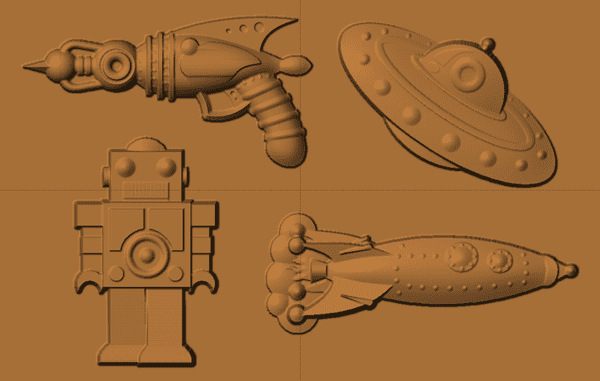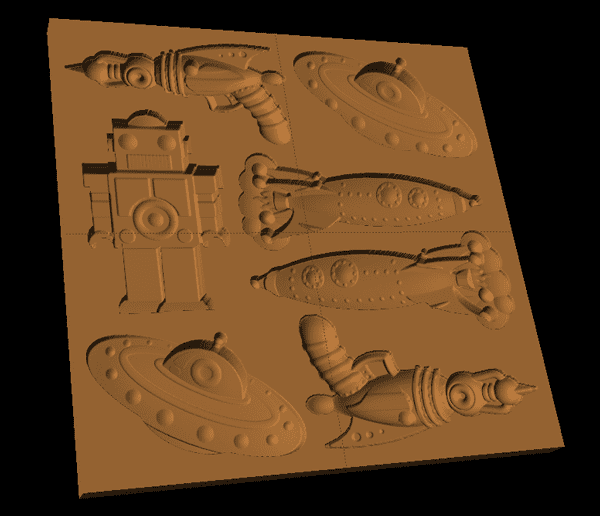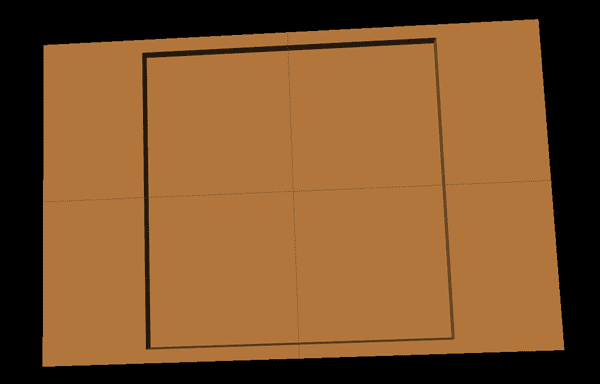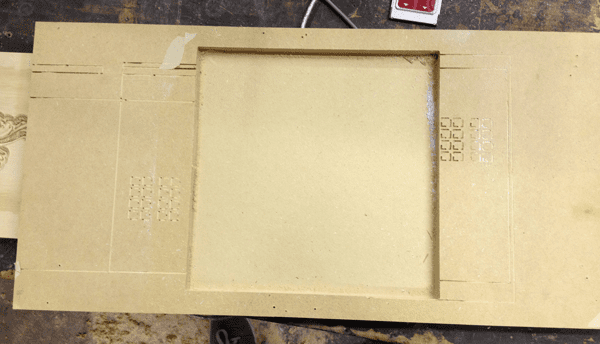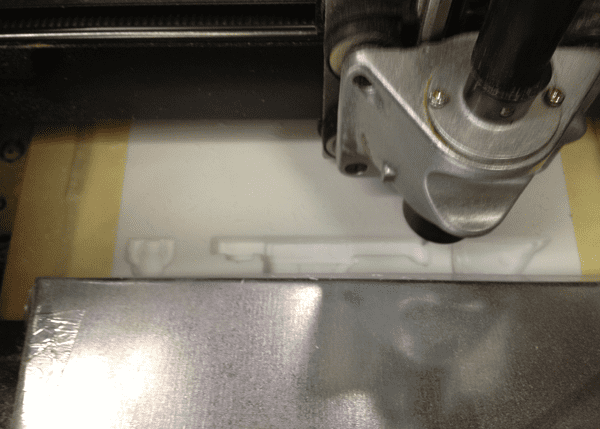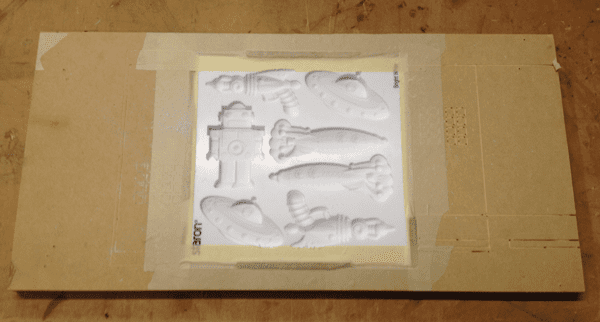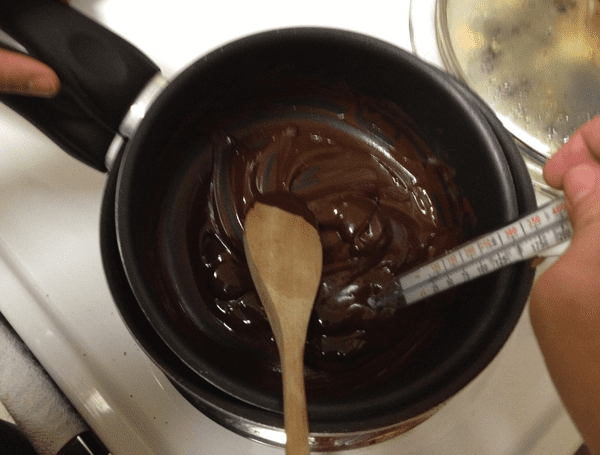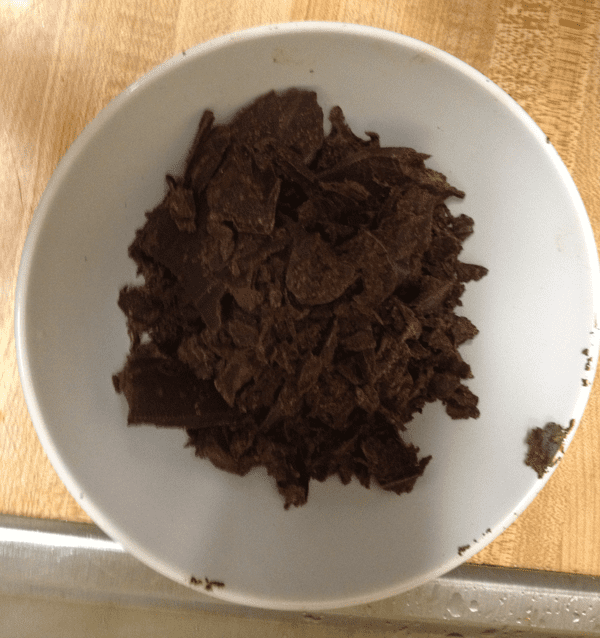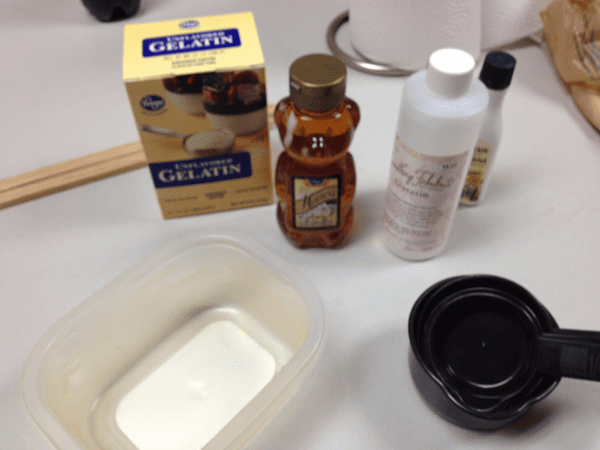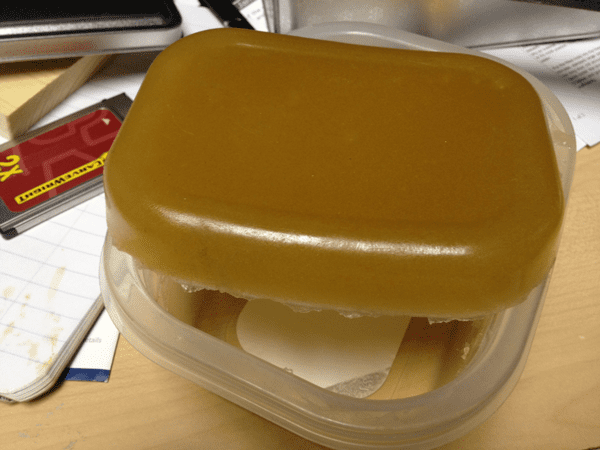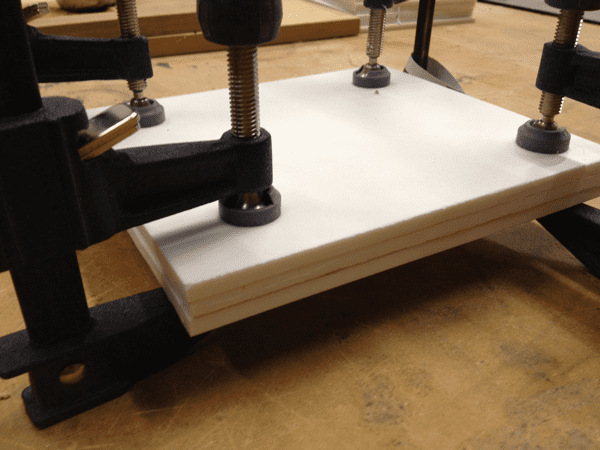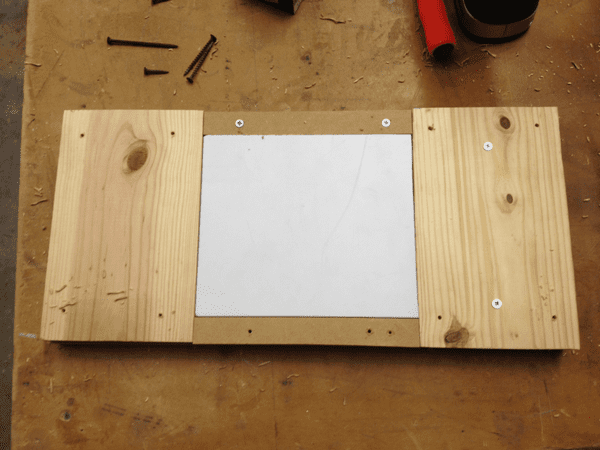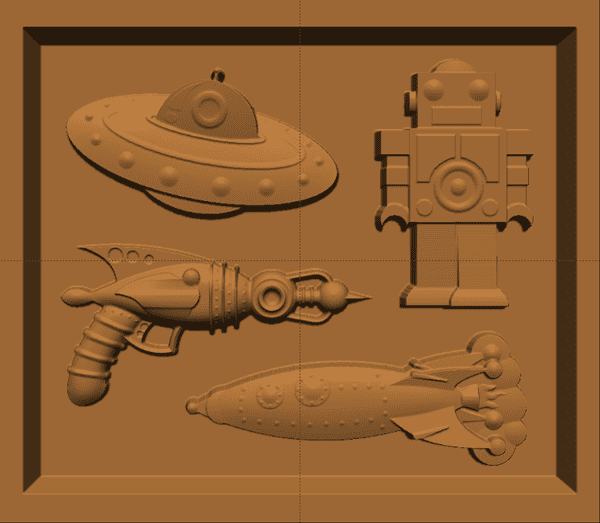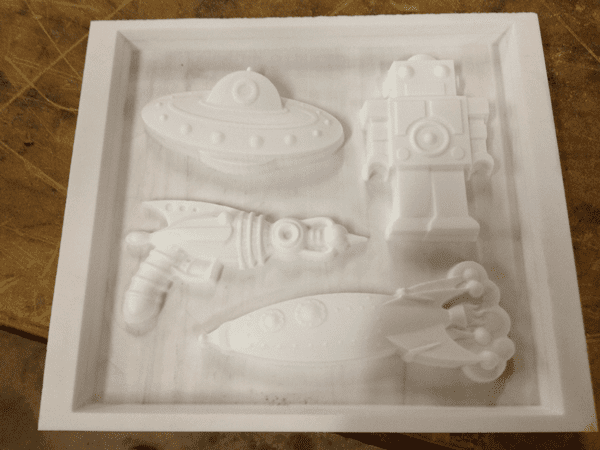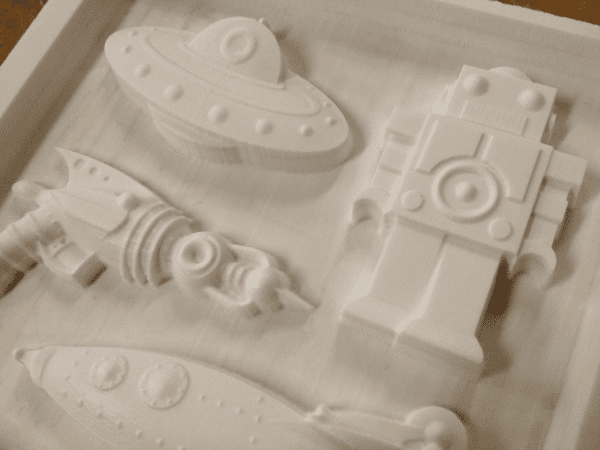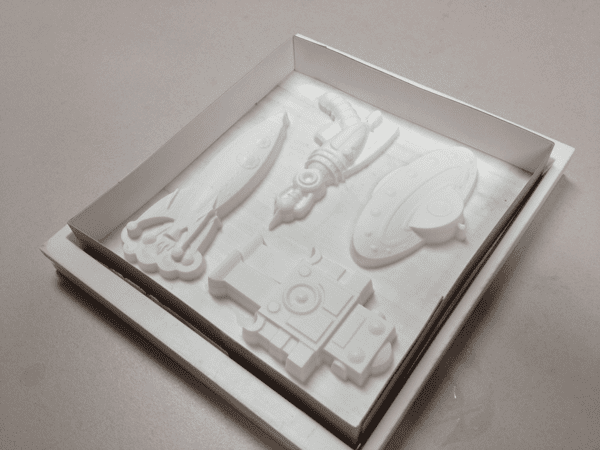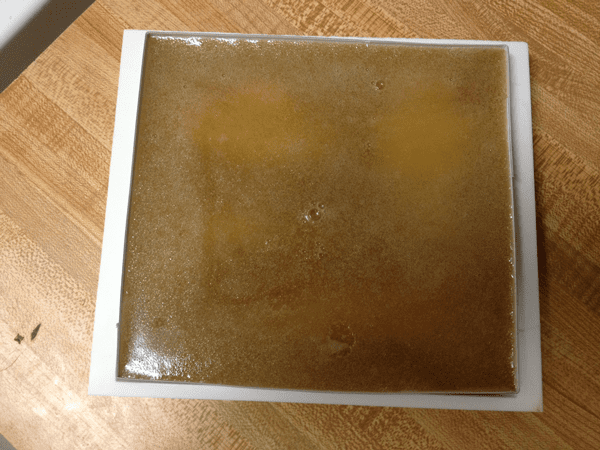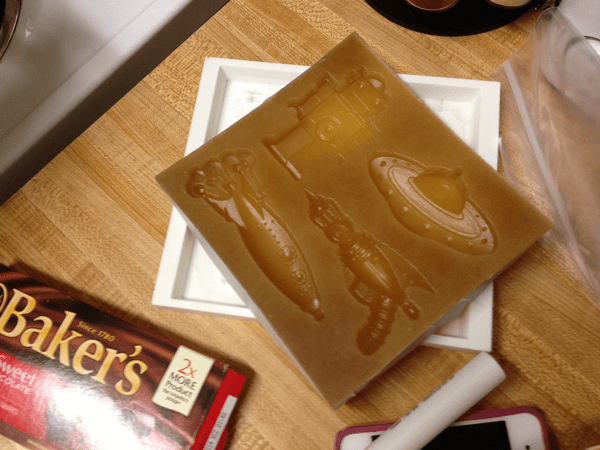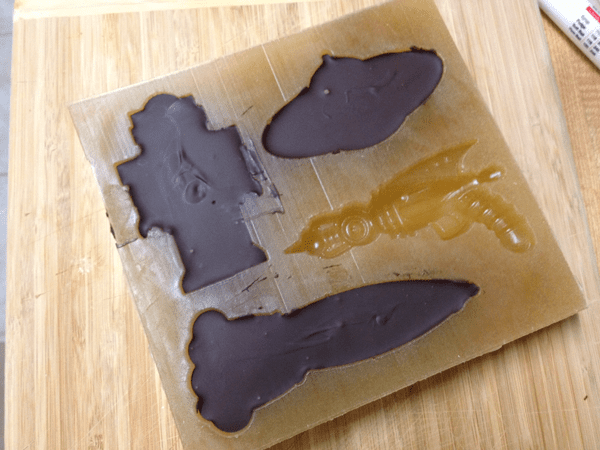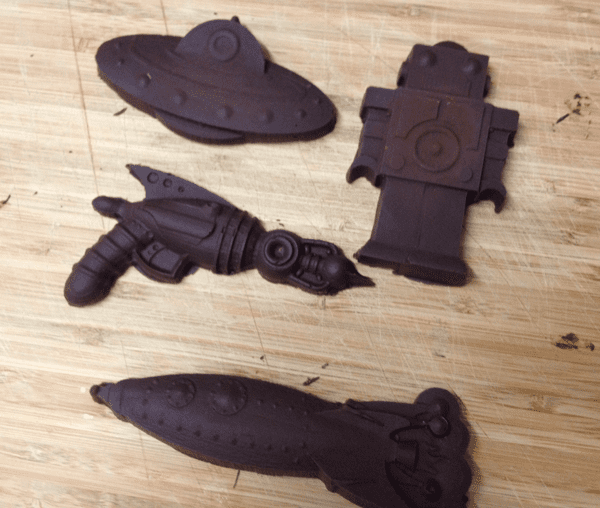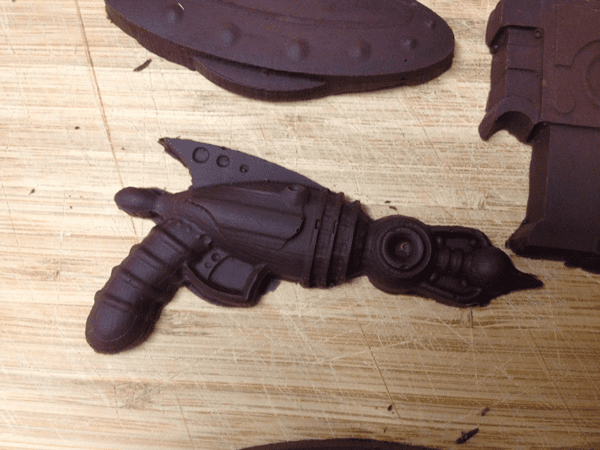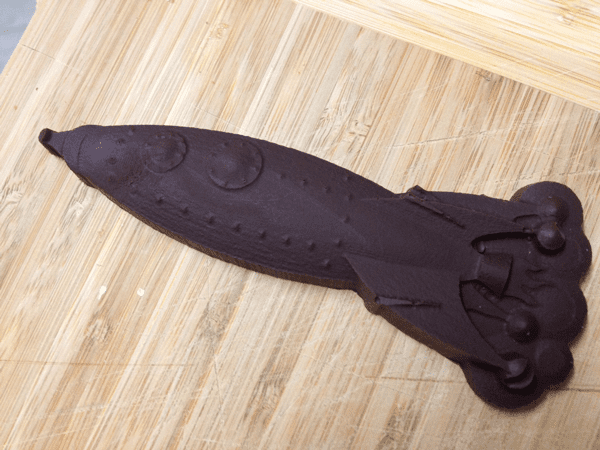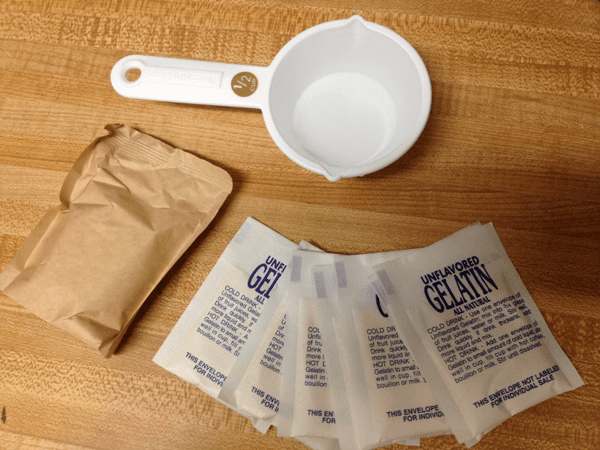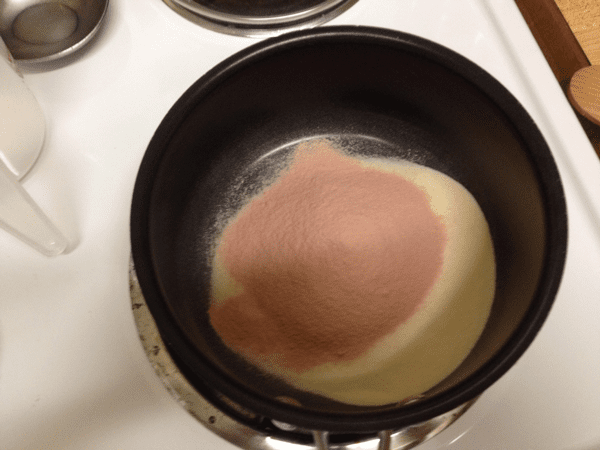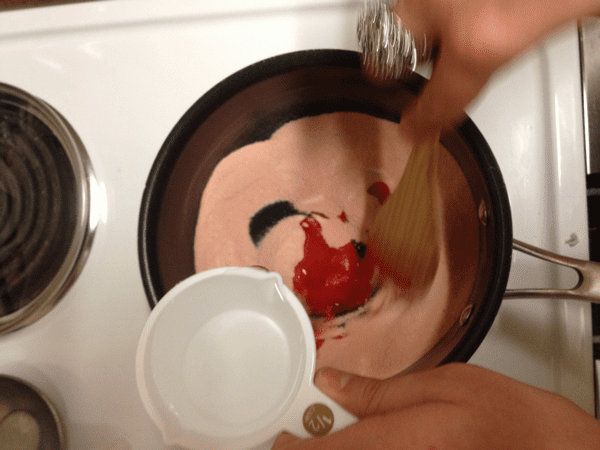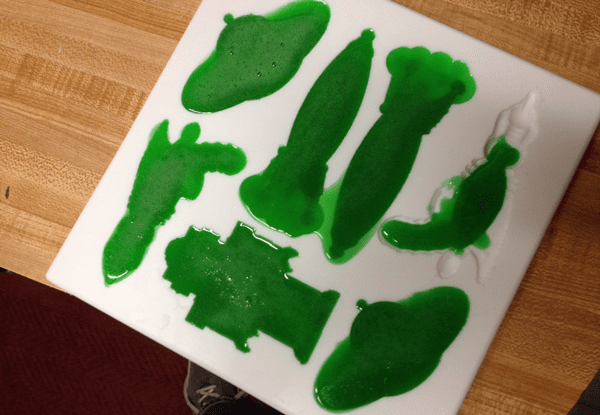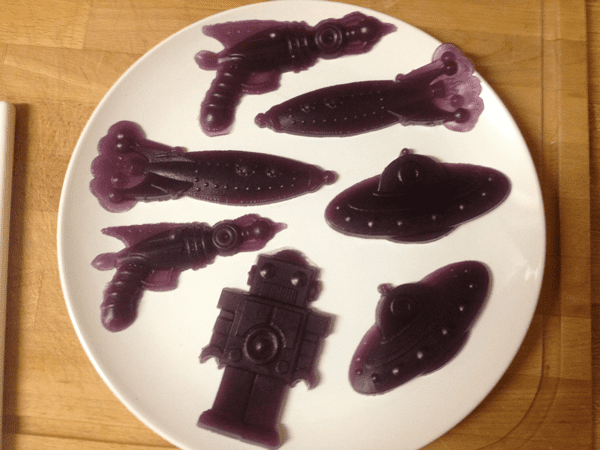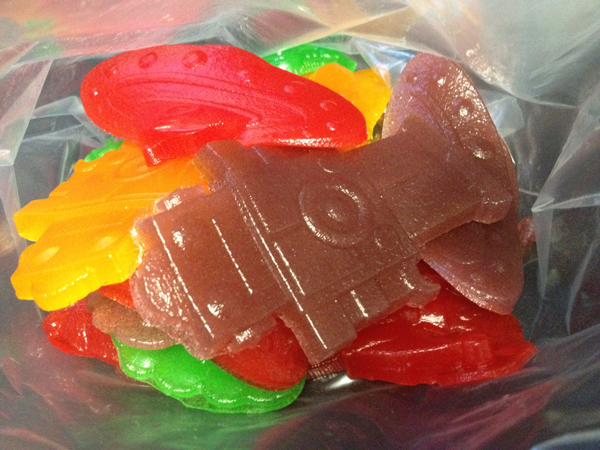Chocolate Molds
I’ve seen over the years several customers playing with mold making with their CarveWright systems. The machine is so perfect for doing this kind of thing, but I had never experimented with it, until now. I’m going to explore actually making a complete product all the way to the packaging, using the machine to make production molds.
Step 1- Idea
Ok, to get started here, we need to decide on a product to cast. I’ve seen a couple customers doing chocolate molds, so I thought this would be really fun. Next we need a theme for the chocolates. We could do something like this for gifts, or as a promotional item for a corporate event or some other kind of organization, or just for fun. I’m a fan of Science Fiction, and in particular, I enjoy the vintage stuff from the 40’s and 50’s. So I decide to make rockets, robots. and raygun chocolates.
Step 2 – Design
Using the CarveWright Modeling Suite, I created some appropriately vintage looking pattern models. Of course you can find many patterns already modeled to use for your molds, but I had a vision and the tools to make it. These pattens I made are available in the CarveWright Pattern Depot for sale and download.
Step 3 – Experiment
Experiment 1 – Carving A Negative Mold
Now that I have my designs created and ready to carve I need to pick a suitable material to carve these into. I have a piece of 1/2″ Corian here that was a sample that one of the manufactures sent me awhile back. I think I’ll carve my first mold into it. Corian carves really cleanly without any sanding or fuzzies to worry about. These chocolates aren’t very big, so I need to be able to get as much detail into them as possible. Plus it is food safe, which is very important when you are casting any item that will be eaten.
Since I will be pouring the chocolates into the mold I’ll need to invert them, and lay them out to to maximize the use of the Corian piece I have. The Corian is 10×10″ and I made each mold pattern about 4″ in it’s longest dimension. This should make a perfect size chocolate for what I’m doing. These patterns will need to be bit optimized. I set these all to High, rather than best to keep the edges as clean as I could. I also played with a small draft on some of these to try and make the casts release easier. This is where you need to zoom in and play with these settings to make sure all the little details are going to come out as you want them.
Remember, if you see it on the screen, you will see it in the carving.
I’ll need a jig for the Corian as well, so I’ll use the machine to make it. The Corian piece is 10″x10″x1/2″ so I made a project board 7″ longer and and 1″ wider. Then I drew a 10″x10″ square, made it a carved region at 1/2″ deep and centered it on both axes. End result is a 17″x11″x.75″ board with my pocket for my Corian in the middle.
Now its time to upload these and head to the shop to do some carving. The molds I will be carving in Optimal so I get as clean and sharp a carve as possible. The jig, I’ll carve in draft, so it is fast and the quality doesn’t matter.
I found a scrap piece of MDF to use for my sled. Looks like it had been used for this purpose before. I keep alot of MDF around for making sleds. It is easy to work and nice and flat. As always with MDF I ran masking tape along the bottom edge that will be riding along the tracking roller. Then I ran the project. Below is the finished jig.
Next is to place my Corian in the jig. You’ll notice, my Corian is actually Staron by Samsung. Same product, different manufacturer.
When I am carving corian, I always use a double stick tape to help hold down the corian. The last thing you want it to move during a carve. I also shimmed the edges where I had gaps and put masking tape over the edges just to make sure it was all tight and secure.
The carve is doing great! Nice and smooth and clean. BTW, I’m using a DC Insert made by long time CarveWright user, Floyd Harris. I won’t run a machine without a dust collection hood. It just makes things so much easier and better.
The mold carve finished and looks perfect. The corian and the optimal carve made the results nearly perfectly smooth.
Now it’s time to wash this thoroughly before making my chocolates. I think am going to run it through the dishwasher.
Experiment 1 – Pouring Test
Spent the weekend pouring chocoloates…
Using a double boiler to melt the chocolate. Put water in the bottom pot and the set a smaller pot with the chocolate into the water. You don’t need to boil the water, just heat it up. I used a candy thermometer to make sure the chocoloate didn’t get too hot. You want to be around 110º F.
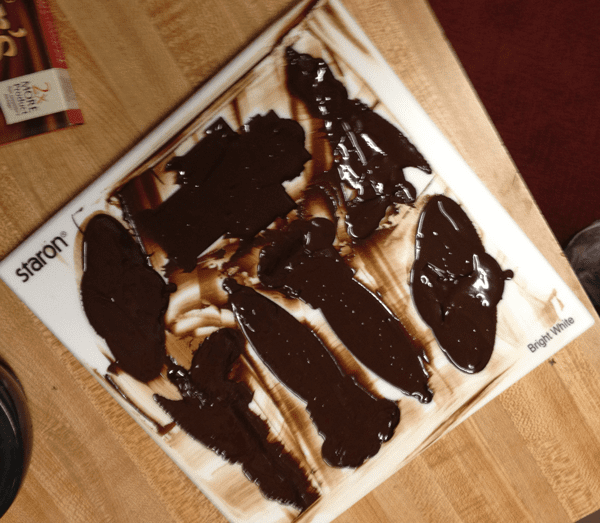
Experiment 1 – Result: Failure
This mold did not work!! Because the mold is so rigid, I couldn’t get the chocolates to release. I ended up digging them out one small chunk at a time.
Experiment 2 – Carving A Positive Mold
Well, off to plan B. I anticipated this and had another idea ready in the wings.
A lot of commercial molds you can buy are made of silicone rubber. After looking into buying some food safe silicone and seeing the prices, I decided to try something else. I had read about gelatin molds on Instructables.com awhile back and thought I’d like to try them for casting parts. Since gelatine is obviously food safe, I decided this was the time to play around with it. After researching several recipes I found one that seemed easy enough and didn’t require ordering a bunch of stuff off the web. I went down to my local supermarket and Hobby Lobby and picked up all the materials for about $12. It requires only 4 ingredients. Gelatin, glycerine, honey, and water.
Gelatin Mold Recipe
Here is the recipe that I used, borrowed from Instructables.com
The amounts are not too critical, but I used a half a cup as 1 part. 1 part honey 1 part water 2 parts gelatin (found at any supermarket) 2 parts glycerine (Found at Hobby Lobby for around $3 in the soap making section) Measure out the water, honey and glycerine and place in a small plastic container. Warm the container in the microwave, on full power for 20 seconds and give the mixture a really good stir. You want the mix warm to hot but NOT BOILING. Measure out and add the gelatin to the container and start stirring it, you want all the crystals to dissolve. Give the mix another 20 seconds in the microwave if the crystals won't dissolve. Keep stirring and heating as necessary to dissolve the gelatin and give a uniform colour and consistency. DON'T LET THE MIXTURE BOIL! Once the mix has become uniform and a sort of clear goldish brown colour, it's ready for cooling. Stick the container in the fridge or the freezer and leave it for a few hours.
The basic mix is now ready. It will take fairly rough treatment at this stage, so force a finger between the mix and the side of the container and pull out the ‘puck’ of rubbery gelatin mix.
The pucks can be placed in a food bag and stored in the freezer until required. I make up 2 batches like this to get started.
Now I need to carve out a new mold. This time I’ll need to carve the positive so I can cast the gelatin into it.
I want these chocolates to be around 1/2″ thick and I just used my only 1/2″ piece of Corian on the last mold. I do have lots of 1/4″ scrap around however, so I’ll try glueing some together to make a 3/4″ thick board. I am using liquid CA glue, applying liberally and clamping the pieces together.
I let this sit clamped for a day before carving. To carve this, I’ll need a jig. The size of the finished glued up corian was 7″ x 8″, so I built a jig with scrap material to fit this piece into.
Next, I need to redesign the mold files as positives. This design is arranged with a 1/2″ deep carve region around the patterns. The patterns are set to .35″ deep with a small draft on them and bit optimization best. This should give me a lot of detail and the draft will help the mold to release. I then saved and uploaded the files with the optimal setting. Should be about 4 hours of carving.
The carves came out really good. The detail is amazing in this Corian, and my superglue seams held up. ( I was a little worried it might come apart.)
Experiment 2 – Making the Mold
Now after a quick wash in the sink with soap and water, to make sure I’m keeping everything food safe, it’s time to pour our mold. I needed a little more of a form around the edges, so I created one real quick with cardboard.
Next I pulled out the gelatin batches I had in the freezer and put them into one container and placed in the microwave. I cooked it for 20 seconds at a time until it was fully melted again and them poured it into my form. Then it goes in the freezer for an hour or more.
The mold came out prefect. It is very detailed and it is as tough as any silicone I’ve worked with.
Experiment 2 – Pouring Test
Now its ready for Chocolate. I’ll double boil it again like I did before and spoon it into the molds.
After the mold is filled, place in the freezer for about 10 minutes to cool.
Experiment 2 – Result: Success!
The chocolates are finished and they look awesome. The detail all came through perfectly.
Careful not to handle them without gloves as you will leave fingerprints.
Experiment 3 – Making Gummy Candies
I got to thinking about that first mold that didn’t work, and I came up with an idea of how to use it. I have all this gelatin left over, so I researched some recipes for making gummie bears. I found several, so I chose the simpler solution and gave it a try. Here is the simple recipe:
- 7 packets of unlfavored gelatin
- 1 packet of flavored jello (whatever flavor you prefer)
- 1/2 cup of cold water
Open all the unflavored and flavored gelatin and place in a pot on the stove.
Add the the water and stir gently.
Turn the heat on medium and continue gently stirring until all the crystals are dissolved.
Pour the mixture into a measuring cup with a spout for easier pouring.
Pour the mixture into your molds.
Place the molds in the freezer for 10 minutes.
Take them out and remove them from the mold.
Experiment 3 – Results: Yummy Gummies
So now I have custom made chocolates and gummie treats all created with my CarveWright system. Now all these need are some packaging and I have a product. See the next build on stamping to see how I do that.
After trying my gummies, you may want to add some sugar. All that gelatin kind of diluted the flavor. I’ve found several other recipes out there as well. Here is one I think I’ll try for next time:
Explore Project Categories
Customer Stories
News
Subscribe To Our Newsletters
Learning, projects, customer highlights, and promotions in your inbox!


